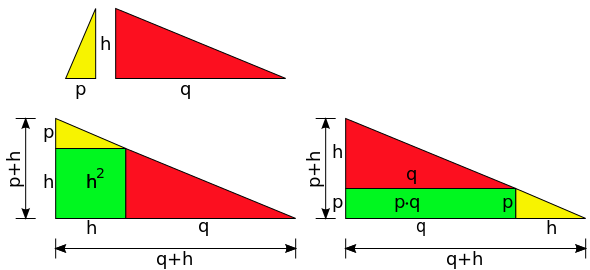Geometric mean theorem
The right triangle altitude theorem or geometric mean theorem is a result in elementary geometry that describes a relation between the lengths of the altitude on the hypotenuse in a right triangle and the two line segments it creates on the hypotenuse. It states that the geometric mean of the two segments equals the altitude.
Theorem and application


If h denotes the altitude in a right triangle and p and q the segments on the hypotenuse then the theorem can be stated as:
or in term of areas:
The latter version yields a method to square a rectangle with ruler and compass, that is to construct a square of equal area to a given rectangle. For such a rectangle with sides p and q we denote its top left vertex with D. Now we extend the segment q to its left by p (using arc AE centered on D) and draw a half circle with endpoints A and B with the new segment p+q as its diameter. Then we erect a perpendicular line to the diameter in D that intersects the half circle in C. Due to Thales' theorem C and the diameter form a right triangle with the line segment DC as its altitude, hence DC is the side of a square with the area of the rectangle.
The converse statement is true as well. Any triangle, in which the altitude equals the geometric mean of the two line segments created by it, is a right triangle.
The geometric mean theorem can also be thought of a special case of the intersecting chords theorem for a circle, since converse of Thales' theorem ensures that the hypothenuse of the right angled triangle is the diameter of its circumcircle.
Historically the theorem is attributed to Euclid (ca. 360–280 BC), who stated it as a corollary to proposition 8 in book VI of his Elements. In proposition 14 of book II Euclid gives a method for squaring a rectangle, which essentially matches the method given here. Euclid however provides different slightly more complicated proof for the correctness of the construction rather than relying on the geometric mean theorem.
Proof
Based on similarity
Proof of theorem: The triangles and are similar, since:
- consider triangles , here we have and , therefore by the AA postulate
- further, consider triangles , here we have and , therefore by the AA postulate
Therefore, both triangles and are similair to and themselves, i.e. .
Because of the similarity we get the following ratio and its algebraic rearrangement yields the theorem:
Proof of converse:
- For the converse we have a triangle in which holds and need to show that the angle at C is a right angle. Now because of we also have . Together with the triangles and have an angle of equal size and have corresponding pairs of legs with the same ratio. This means the triangles are similar, which yields:
Based on dissection and rearrangement

Dissecting the right triangle along its altitude h yields two similar triangles, which can be augmented and arranged in two alternative ways into a larger right triangle with perpendicular sides of lengths p+h and q+h. One such arrangement requires a square of area h2 to complete it, the other a rectangle of area pq. Since both arrangements yield the same triangle, the areas of the square and the rectangle must be identical.
References
- Claudi Alsina, Roger B. Nelsen: Icons of Mathematics: An Exploration of Twenty Key Images. MAA 2011, ISBN 9780883853528, pp. 31–32 (online copy, p. 31, at Google Books)
- Ilka Agricola, Thomas Friedrich: Elementary Geometry. AMS 2008, ISBN 9780821843475, p. 25 (online copy, p. 25, at Google Books)
- Euclid: Elements, book II – prop. 14, book VI – prop. 8, (online copy)